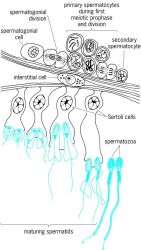Spermatogenesis
The differentiation of spermatogonial cells (primordial germ cells in the testes) into spermatozoa (see illustration).
Spermatogonial divisions occur continuously throughout the life of mammals; these divisions both maintain the stem cell population (spermatogonial cells) and supply cells which develop into sperm. Clusters of spermatogonia maintain communication through cytoplasmic bridges, and these groups become primary spermatocytes when they synchronously enter the first meiotic prophase. The first meiotic prophase is characterized by a series of remarkable changes in chromosome morphology, which are identical to those seen in the corresponding stage of oogenesis. The secondary spermatocyte produced by this division then undergoes a division in which the chromosomes are not replicated; the resulting spermatids contain half the somatic number of chromosomes. See Meiosis
The spermatids become embedded in the cytoplasm of Sertoli cells, and there undergo the distinctive changes which result in formation of spermatozoa. These morphological transformations include the conversion of the Golgi apparatus into the acrosome and progressive condensation of the chromatin in the nucleus. A centriole migrates to a position distal to the nucleus and begins organizing the axial filament which will form the motile tail of the sperm. Mitochondria may fuse to form a nebenkern as is the case for many vertebrates, or there may be less extensive fusion as in mammals. In all cases the resulting structures become located around the axial filament in the midpiece. The cytoplasm of the spermatid is reflected distally away from the nucleus during spermatid maturation; eventually, most of the cytoplasm is sloughed off and discarded.
The Sertoli cells are thought to provide nutrition for the developing sperm, because their cytoplasm contains large stores of glycogen which diminish as spermatids mature. There is no direct evidence for this nutritive function, but some forms of male sterility are associated with the failure to produce normal Sertoli cells. Electron microscopy has revealed distinct plasma membranes surrounding the two cell types at the points of contact, and thus the Sertoli cell-spermatid relationship is not syncytial as once thought.
Spermatogenesis is cyclical to a varying extent depending on the species, and under endocrine control. Spermatogenesis is maintained and regulated by male steroid hormones such as testosterone, which is produced by the interstitial or Leydig cells found in the connective tissue of the testis. Interstitial cells, in turn, are stimulated by luteinizing hormone (LH) which is produced by the pituitary gland. The male testis-regulating hormone was formerly known as interstital cell-stimulating hormone (ICSH), but it is now known to be identical to LH. See Gametogenesis, Testis
spermatogenesis
[spər‚mad·ə′jen·ə·səs]Spermatogenesis
the biological process by which the male diploid sexual cells of animals and many plants are transformed into spermatozoa or haploid cells that are free and highly differentiated.
Four spermatogenic periods are distinguished: division, growth, meiosis, and spermiogenesis (spermioteleosis). During the first period the original diploid male sexual cells (spermatogonia) divide several times by mitosis. (The number of divisions is constant for each species.) During the growth period the sexual cells (primary spermatocytés) enlarge. Their nuclei pass through a long prophase, during which the conjugation of homologous chromosomes and crossing over take place along with the exchange of material between homologous chromosomes. Tetrads are consequently formed. Two meiotic divisions occur, during which the number of chromosomes is reduced or halved. In some tetrads homologous chromosomes disjoin and go to the poles of the spindle in the first division; in the second division chromatids disjoin and go to the poles. In other tetrads the chromatids disjoin before the homologous chromosomes.
Thus, every primary spermatocyte produces two secondary spermatocytes, which, after the second division, form four spermatids, or haploid cells of identical size. The spermatids do not divide and are transformed into spermatozoa after undergoing spermiogenesis. They lose their round shape and become elongated: some new structures are formed (acrosome, paranucleus, flagellum), other structures disappear (ribosomes, endoplasmatic reticulum), and many organelles shift within the cell by telophasic movements. Much of the cytoplasm disappears from the cell. The elongated nucleus, the condensed chromatin, and the acrosome (a derivative of the Golgi complex) are situated at the apical pole of the cell, forming the head of a spermatozoon. The centriole, which is usually near the basal nuclear pole, gives rise to a flagellum. Mitochondria surround the centriole or form the paranucleus, situated in the interstitial space of a spermatozoon.
REFERENCES
Rukovodstvopo tsitologii, vol. 2. Moscow, 1966.Derobertis, E., W. Nowinski, and F. Saez. Biologiia kletki. Moscow, 1967. (Translated from English.)
The Cell, vol. 3. New York-London, 1961.
L. V. DANILOVA
